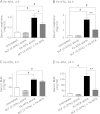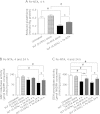Bovine lactoferrin ameliorates ferric nitrilotriacetate-induced renal oxidative damage in rats
- PMID: 22962523
- PMCID: PMC3432831
- DOI: 10.3164/jcbn.11-100
Bovine lactoferrin ameliorates ferric nitrilotriacetate-induced renal oxidative damage in rats
Abstract
Milk provides a well-balanced source of amino acids and other ingredients. One of the functional ingredients in milk is lactoferrin (LF). LF presents a wide variety of bioactivities and functions as a radical scavenger in models using iron-ascorbate complexes and asbestos. Human clinical trials of oral LF administration for the prevention of colon polyps have been successful and demonstrated that dietary compounds exhibit direct interactions. However, antioxidative properties of LF in distant organs require further investigation. To study the antioxidant property of LF, we employed bovine lactoferrin (bLF) using the rat model of ferric nitrilotriacetate (Fe-NTA)-induced renal tubular oxidative injury. We fed rats with bLF (0.05%, w/w) in basal chow for 4 weeks and sacrificed them after Fe-NTA treatment. After intraperitoneal administration of 9.0 mg iron/kg Fe-NTA for 4 and 24 h, bLF pretreatment suppressed elevation of serum creatinine and blood urea nitrogen levels. In addition, we observed protective effects against renal oxidative tubular damage and maintenance of antioxidant enzyme activities in the bLF-pretreated group. We thus demonstrated the antioxidative effect of bLF against Fe-NTA-induced renal oxidative injury. These results suggest that LF intake is useful for the prevention of renal tubular oxidative damage mediated by iron.
Keywords: chemoprevention; ferric nitrilotriacetate; glutathione metabolism; lactoferrin; oxidative renal damage.
Figures




References
-
- Toyokuni S. Iron as a target of chemoprevention for longevity in humans. Free Radic Res. 2011;45:906–917. - PubMed
-
- Diplock AT, Charleux JL, Crozier-Willi G, et al. Functional food science and defence against reactive oxidative species. Br J Nutr. 1998;80 (Suppl 1):S77–S112. - PubMed
-
- Raghuveer TS, McGuire EM, Martin SM, et al. Lactoferrin in the preterm infants’ diet attenuates iron-induced oxidation products. Pediatr Res. 2002;52:964–972. - PubMed
-
- Lönnerdal B. Nutritional and physiologic significance of human milk proteins. Am J Clin Nutr. 2003;77:1537S–1543S. - PubMed
-
- Aisen P, Leibman A. Lactoferrin and transferrin: a comparative study. Biochim Biophys Acta. 1972;257:314–323. - PubMed

